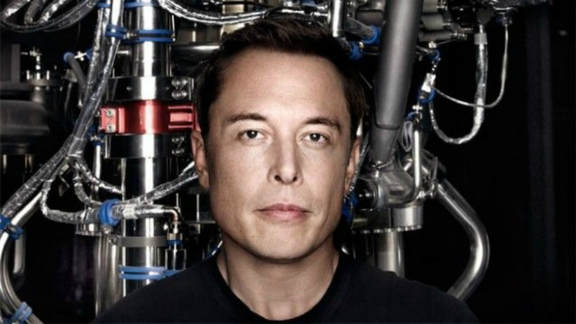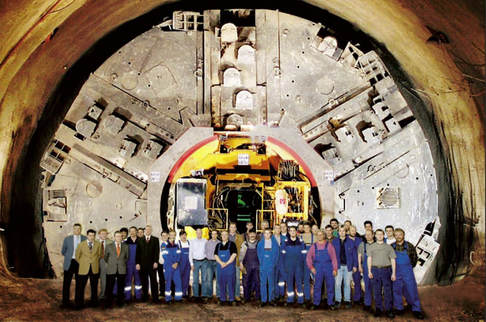The Musk Plan To Fix The World
By James Donahue
Fifty-seven-year-old Elon Musk is a man with an amazing mission. He says his goals are to change the world and humanity, reduce global warming and consequently reduce the risk of human extinction. And if the stogy controls of government and corporate powers don’t block him, he just might succeed.
Musk’s name has been in the news a lot lately because the mighty SpaceX rocket his company built succeeded in lifting a Tesla automobile off into space. The rocket appears superior to anything NASA ever built and is already being used to hoist various satellites into orbit, portions of the rocket are being recovered for re-use, and is considered a candidate for Musk’s plan to sponsor a manned flight to Mars.
Musk also is the founder of SolarCity, a company involved in sustainable energy production, is proposing a new method of high speed air travel on electric aircraft using electric fan propulsion, has a plan to develop high speed Internet for international use via a multi-satellite system, is working toward establishing a human colony on Mars and is busy burrowing Hyperloop, an underground high-speed transportation system that will move people from city to city on high speed rail.
Critics laughed at Musk’s ideas at first. But his successful ventures of late have been capturing the imagination of the world. The man is overcoming almost insurmountable odds to build the tools humanity needs to accomplish the future world Musk has outlined. That he follows in the footsteps of the late electronic and energy genius Nicholai Tesla, after whom he named his car company, reflects upon the same mindset Musk appears to share with Tesla. And that frightens the capitalistic powers now in place that are prepared to block his every move.
Born in South Africa in 1971, Musk proved to be a child genius. He mastered computer programming by the time he was 12. He moved to Canada at the age of 17 to attend Queen’s University. From there he transferred to the University of Pennsylvania where he earned an economics degree from the Wharton School and a master’s degree in physics from the College of Arts and Sciences. After this Musk actively pursued the finances he needed to change the world.
He began by co-founding a web software company that was sold to Compaq for $340 million in 1999. From there he founded an online financial business that evolved into PayPal and that sold to eBay for $1.5 billion in 2002. That same year Musk founded SpaceX, an aerospace manufacturer and space transport services operation. He remains that company’s CEO and lead designer.
An obvious multi-tasker, by 2003 Musk established the Tesla Company for building electric cars and solar panels. He then was involved in the creation of SolarCity, a solar energy services company that operates as a subsidiary of Tesla Company.
Branching out into other futuristic areas of interest, since 2015 Musk co-founded OpenAI, a company working on artificial intelligence; Neuralink, a company involved in brain-computer interfaces, and most recently, he founded The Boring Company, which is already tunneling across the United States.
Musk has been so successful in his many business ventures by 2016 he was ranked twenty-first on the Forbes list of the World’s Most Powerful People. He currently is estimated to have a net worth of $20.8 billion. Thus, unlike the poverty stricken Tesla, Musk acquired his wealth first and thus is promising to have a better chance of success at making his dream for the world come into reality.
While we have had few peeks into the research going on in some of the Musk-sponsored projects, his firing of his SpaceX rockets have been making headlines. Millions have watched his successful launches on nightly television. And now the news is zeroing in on his plans to burrow for his “Hyperloop” underground high-speed transportation system.
The massive burrowing machines appear to already be at work under southern California. A two-mile test track is now under construction leading from Musk’s SpaceX rocket-manufacturing plant leading west under 120th Street toward the 405 Freeway. Long range plans have it connecting there to a primary tunnel network called Loop that would run from Long Beach Airport to Sherman Oaks, parallel to the 405. Side tunnels would carry passengers to and from LA International Airport and Dodger Stadium, and from South Bay beach cities to the beaches at Santa Monica.
Cars will not be used in these tunnels. Instead, passengers will be placed in pods attached to skates affixed to a track. These pods would move at high speed from place to place, thus moving large numbers of people and easing the heavy traffic patterns now clogging the road systems above.
Musk has just managed a preliminary permit to begin digging a similar test tunnel under Washington D.C. If he can get through all of the red tape imposed upon his company, he plans another high-speed transit system from Washington east through the heavily populated areas in New York and northward.
We can only imagine a future of high-speed underground travel in Musk’s tunnels, someday carrying us from L.A. to New York, south to Miami and west to Chicago and Spokane, getting us there at speeds faster than contemporary aircraft.
The futuristic world of Musk and other inventors and visionaries is just around the corner. All we need to do is elect leadership to public office that shares in these visions.
By James Donahue
Fifty-seven-year-old Elon Musk is a man with an amazing mission. He says his goals are to change the world and humanity, reduce global warming and consequently reduce the risk of human extinction. And if the stogy controls of government and corporate powers don’t block him, he just might succeed.
Musk’s name has been in the news a lot lately because the mighty SpaceX rocket his company built succeeded in lifting a Tesla automobile off into space. The rocket appears superior to anything NASA ever built and is already being used to hoist various satellites into orbit, portions of the rocket are being recovered for re-use, and is considered a candidate for Musk’s plan to sponsor a manned flight to Mars.
Musk also is the founder of SolarCity, a company involved in sustainable energy production, is proposing a new method of high speed air travel on electric aircraft using electric fan propulsion, has a plan to develop high speed Internet for international use via a multi-satellite system, is working toward establishing a human colony on Mars and is busy burrowing Hyperloop, an underground high-speed transportation system that will move people from city to city on high speed rail.
Critics laughed at Musk’s ideas at first. But his successful ventures of late have been capturing the imagination of the world. The man is overcoming almost insurmountable odds to build the tools humanity needs to accomplish the future world Musk has outlined. That he follows in the footsteps of the late electronic and energy genius Nicholai Tesla, after whom he named his car company, reflects upon the same mindset Musk appears to share with Tesla. And that frightens the capitalistic powers now in place that are prepared to block his every move.
Born in South Africa in 1971, Musk proved to be a child genius. He mastered computer programming by the time he was 12. He moved to Canada at the age of 17 to attend Queen’s University. From there he transferred to the University of Pennsylvania where he earned an economics degree from the Wharton School and a master’s degree in physics from the College of Arts and Sciences. After this Musk actively pursued the finances he needed to change the world.
He began by co-founding a web software company that was sold to Compaq for $340 million in 1999. From there he founded an online financial business that evolved into PayPal and that sold to eBay for $1.5 billion in 2002. That same year Musk founded SpaceX, an aerospace manufacturer and space transport services operation. He remains that company’s CEO and lead designer.
An obvious multi-tasker, by 2003 Musk established the Tesla Company for building electric cars and solar panels. He then was involved in the creation of SolarCity, a solar energy services company that operates as a subsidiary of Tesla Company.
Branching out into other futuristic areas of interest, since 2015 Musk co-founded OpenAI, a company working on artificial intelligence; Neuralink, a company involved in brain-computer interfaces, and most recently, he founded The Boring Company, which is already tunneling across the United States.
Musk has been so successful in his many business ventures by 2016 he was ranked twenty-first on the Forbes list of the World’s Most Powerful People. He currently is estimated to have a net worth of $20.8 billion. Thus, unlike the poverty stricken Tesla, Musk acquired his wealth first and thus is promising to have a better chance of success at making his dream for the world come into reality.
While we have had few peeks into the research going on in some of the Musk-sponsored projects, his firing of his SpaceX rockets have been making headlines. Millions have watched his successful launches on nightly television. And now the news is zeroing in on his plans to burrow for his “Hyperloop” underground high-speed transportation system.
The massive burrowing machines appear to already be at work under southern California. A two-mile test track is now under construction leading from Musk’s SpaceX rocket-manufacturing plant leading west under 120th Street toward the 405 Freeway. Long range plans have it connecting there to a primary tunnel network called Loop that would run from Long Beach Airport to Sherman Oaks, parallel to the 405. Side tunnels would carry passengers to and from LA International Airport and Dodger Stadium, and from South Bay beach cities to the beaches at Santa Monica.
Cars will not be used in these tunnels. Instead, passengers will be placed in pods attached to skates affixed to a track. These pods would move at high speed from place to place, thus moving large numbers of people and easing the heavy traffic patterns now clogging the road systems above.
Musk has just managed a preliminary permit to begin digging a similar test tunnel under Washington D.C. If he can get through all of the red tape imposed upon his company, he plans another high-speed transit system from Washington east through the heavily populated areas in New York and northward.
We can only imagine a future of high-speed underground travel in Musk’s tunnels, someday carrying us from L.A. to New York, south to Miami and west to Chicago and Spokane, getting us there at speeds faster than contemporary aircraft.
The futuristic world of Musk and other inventors and visionaries is just around the corner. All we need to do is elect leadership to public office that shares in these visions.

